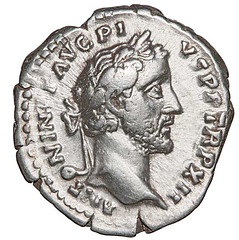
PREV ARTICLE
NEXT ARTICLE
FULL ISSUE
PREV FULL ISSUE
VOCABULARY TERMS: METAL FLOW, FLOW MARKSDick Johnson submitted these entries from his Encyclopedia of Coin and Medal Terminology. Thanks. -Editor   Flow marks on a silver denarius of Antoninus Pius, from Forum Ancient Coins. Metal Flow. The movement of metal in a blank at the instant of striking as it flows into the cavities of the dies under pressure during striking in a press. Metal flow is this metal movement, the result is called DISPLACEMENT. Metal flow occurs throughout the mass of the blank, but is most severe at and near the surface. SURFACE DISPLACEMENT is the metal flow that creates the design, where the metal flows into all the contours and cavities of both dies. Metal flow can also (but not always) cause microscopic surface striations, parallel ridges and channels, generally from the outer rim inwards as the metal is displaced to the area of the greatest cavities of the dies. These striations, FLOW MARKS, are the cause of LUSTER, and, very infrequently, CARTWEEEL EFFECT. The pressure at the instance of the BLOW to the blank is the power that generates metal flow. It is so strong during striking in a press that it can move metal deep within the mass of the blank. The surface metal that flows into the die cavities is replaced by adjacent metal, and this, in turn moves its adjacent metal. The movement continues until both surfaces of the blank fit the shape of both dies. Metal flow stops at the instant the dies are fully extended and there is no more pressure. However, in rare instances, as the dies retract some metal may spring back somewhat
(by MOLECULAR MEMORY) and cause DIE DRAW. This is cured in coining with a slightly stronger impression. See also STRIKING, SUCTION. Flow Marks. Minute striations or corrugations on the surface of a freshly struck coin or medal. Flow marks are caused by the surface displacement of metal as the piece is struck, generally forming a microscopic pattern of ridges and channels — appearing to the naked eye as radial lines — which tend to form from the center outward toward the rim. They are best viewed in the field where no relief is present. Flow marks on a struck piece are the cause of LUSTER (also called MINT LUSTER) by reflecting light in a distinctive way; it is also the cause of CARTWHEEL EFFECT. The slightest wear or handling will diminish or erase flow marks (the minute channels fill with dirt, grease, human perspiration, oils, other contaminates or fluids the piece has come in contact with). This reduces the surface metal's unusual reflective quality, tarnish and wear begins. Flow marks disappear rapidly as coins circulate or are handled; because of this they are an excellent criteria to distinguish true uncirculated pieces. (Collectors call the existence of flow marks a DIAGNOSTIC of MINT STATE where the piece has never been mishandled or circulated.) In addition to wear or handling where contaminates fill the channels, any type of processing — polishing or whizzing — will remove flow marks. There is no known method of artificially returning flow marks once they have disappeared. They are very fragile, and once gone, cannot be restored. Flow marks can be seen under low power magnification (3x to 10x) but are even more obvious under greater magnifications. Flow marks do not appear on proof coins because of the smooth polished surfaces, of both dies and planchets. Likewise in medallic work, any flow marks are removed by the finishing process. Thus flow marks are characteristic of uncirculated coins only. White metal flow marks. An unusual situation exists for certain white metal alloys with high TIN content. Flow marks on such pieces, where the METAL STRESS is the
greatest, will not tarnish but remain bright forever. The surface of certain white metal medals exhibit this phenomenon; the remainder of the piece will TONE or TARNISH (actually
turn dark gray to black), but the flow mark high stress areas will remain bright. Thus the bright area is a reverse bright "shadow" in contrast to the naturally dark toned
surface. See WHITE METAL. Looking for the meaning of a numismatic word, or the description of a term? Try the Newman Numismatic Portal's Numismatic Dictionary at: https://nnp.wustl.edu/library/dictionary Or if you would like a printed copy of the complete Encyclopedia, it is available. There are 1,854 terms, on 678 pages, in The Encyclopedia of Coin and Medal Technology. Even running two a week would require more than 19 years to publish them all. If you would like an advance draft of this vital reference work it may be obtained from the author for your check of $50 sent postpaid. Dick Johnson, 139 Thompson Drive, Torrington, CT 06790. Wayne Homren, Editor The Numismatic Bibliomania Society is a non-profit organization promoting numismatic literature. See our web site at coinbooks.org. To submit items for publication in The E-Sylum, write to the Editor at this address: whomren@gmail.com To subscribe go to: https://my.binhost.com/lists/listinfo/esylum All Rights Reserved. NBS Home Page Contact the NBS webmaster 
|